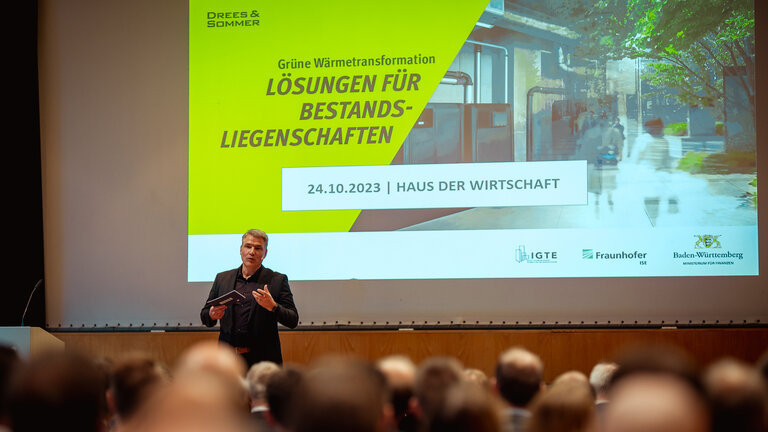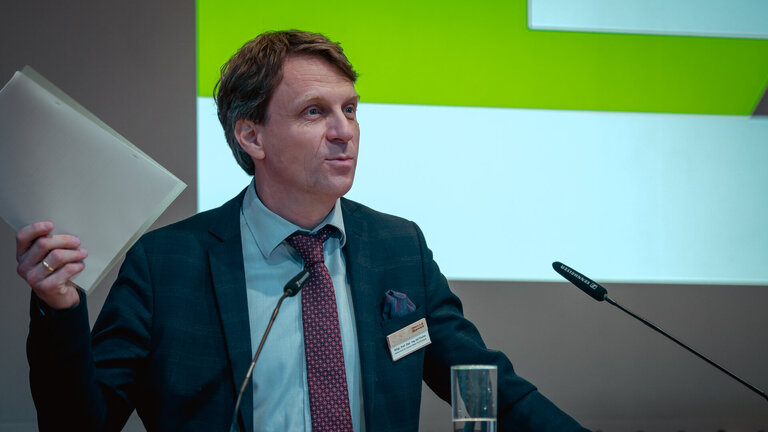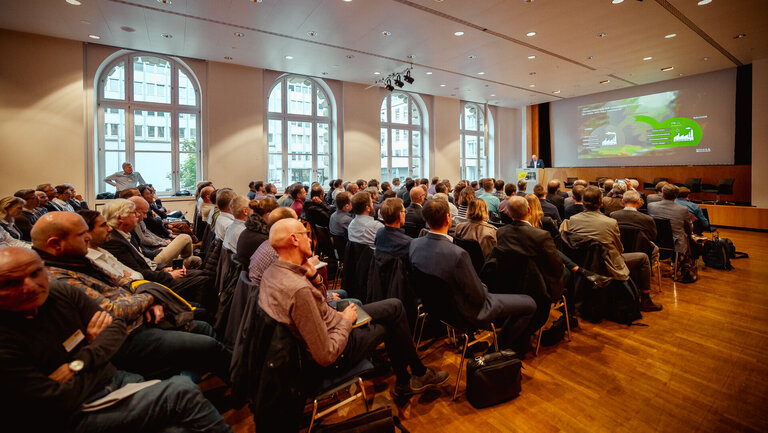The transformation in the heating sector is still only progressing slowly in Germany. Yesterday’s event at Stuttgart’s Haus der Wirtschaft, entitled ‘Grüne Wärmetransformation – Lösungen für Bestandsliegenschaften’ (Green Heating Transformation – Solutions for Existing Properties), explored the question of how the transition can be accelerated as quickly as possible. Hosts were the Baden-Württemberg Ministry of Finance, the consulting firm Drees & Sommer SE, the Institute for Building Energetics, Thermotechnology and Energy Storage (IGTE) of the University of Stuttgart, and the Fraunhofer Institute für Solar Energy Systems. More than 130 persons attended the conference. Guests were mostly building owners, developers, planning and consulting firms, experts from the world of science, companies of the energy sector and executing enterprises.
The existing buildings in all sectors of the market must become climate-neutral as quickly as possible, which especially means that the net emissions of CO2 must be practically eliminated. The green transformation of the heating sector plays a key role here in the transition to climate neutrality. Although there are economically feasible solutions for regenerative power generation using photovoltaic systems and wind energy, there are not yet any such solutions for the green transformation of heating in existing buildings,” says Professor Dr. Michael Bauer, Partner at Drees &Sommer SE.
The provision of heating represents more than half of the total final energy consumption in Germany. This includes indoor room heating, hot water, process heat and the heat needed for refrigeration. In addition to measures to increase energy efficiency, the use of renewable energy sources must play a much greater role. The contribution of renewable energy sources to German heat consumption has only increased slightly since 2013.[1] Currently it is about 17.4 percent, which is less than a fifth. In the provision of heat alone, half of the private households in Germany use gas and about a further 20 percent use heating oil.[2]
Difficult Choice? Municipal Heat Planning Provides Clarity
Under the planned German Municipal Heat Planning Act (Gesetz zur kommunalen Wärmeplanung), within the next five years all local communities in Germany must present plans showing how they will ensure a climate-friendly supply of heat. A special focus must be placed on the potential to connect buildings to district heat networks. “For building owners, this also provides a basis for planning which will enable them to decide what type of heating system is most suitable for their building. In cities and densely populated areas, connections to local or remote district heat networks, which will be increasingly climate-neutral in future, is a very good solution to enable users to move away from fossil-based heating systems,“ comments Dr. Michael Bauer.
Consistent Plan for Properties of the Federal State of Baden-Württemberg
The federal state government of Baden-Württemberg also wants to achieve a significant increase in the use of heat pumps, as Professor Kai Fischer, Ministerial Director at the Ministry of Finance of the federal state explains.
“Our federal state buildings play a crucial role in the goal of reducing CO2 emissions in the federal state administration. 80 percent of the carbon dioxide emissions of the federal state administration are caused by the federal state buildings, that means higher education institutions, police headquarters and revenue services. By 2030, the federal state administration aims to achieve net greenhouse gas neutrality. Our energy and climate concept[3] illustrates how the federal state’s properties will contribute to this target ,“ explains Professor Fischer.
Thus, in future the federal state government will no longer use heating oil for heat production, and in its own heating installations it will replace it by renewable energy sources by 2028. “In new or modernized heating systems we now only use natural gas in exceptional cases. Moreover, we are no longer expanding those combined heat and power plants or heat and power co-generation plants which use fossil fuels.“
Industry Faces Enormous Challenges as well
Not only private households and the public sector are facing enormous challenges: “Industry is still at square one in the green transformation of heating. Large-scale heat pumps, local and district heat networks, geothermal energy and waste heat from industrial processes and sewers will characterize the heating infrastructure of the future. An effective key to the success of ‘zero carbon’ also lies in sector coupling. Here, sectors such as industry, mobility, heat and electricity are no longer seen in isolation, they interact with each other,“ points out Michael Bauer.
Professor Dr. Michael Bauer concludes: “We can only achieve transformation in the heat supply, which is so important for our society, by combining different sectors. Different branches of industry and all participants in the building sector must engage in intensive discussions, learn from each other's strategies and measures, and ideally coordinate their needs. We can only make significant progress in our climate goals if we work together.“
For more information please see our press release.
[1]Energieverbrauch für fossile und erneuerbare Wärme | Umweltbundesamt
(in German language, German Environment Agency: energy consumption for fossil and renewable heat)
[2]https://www.destatis.de/EN/Press/Graphics/Newsroom/2022/_Interactice/20221219-energy-sources-heating.html
[3] Concept for climate neutrality by 2030 – energy and climate protection concept for properties of the federal state: Klimaschutz fuer eine lebenswerte Zukunft (baden-wuerttemberg.de) (in German language; climate protection for a livable future)


